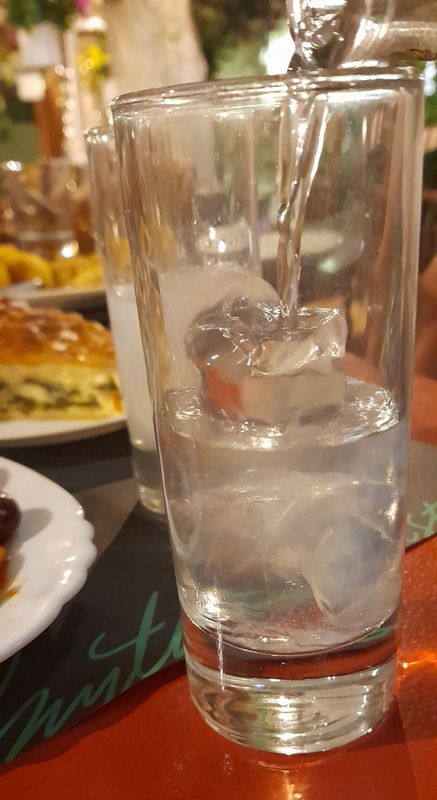Whoever hasn’t sipped a glass of ouzo on the rocks, whoever hasn’t caught himself dreaming as he watched the transparent liquid turn milky white, whoever hasn’t felt his palate fill up with the sweet, aniseed-flavored aroma, can’t fully understand the taste of Greek summer! For, more than the national drink, ouzo is a concentrate of Greece: with every sip, it opens a window onto the islands, the blue sea, the table full of mezzés…
Ouzo, a secret recipe

In Greece, there are as many different ouzos as there are producers! Each one has its own recipe, jealously guarded to pass on to the next generation. But the basic manufacture of ouzo is common: a copper still called amvikas (άμβυκας) in Greek, 96-100° alcohol from agricultural produce and aromatics, including anise. Moreover, since 1989, the drink has had to be produced in Greece to qualify for the Ouzo appellation. The main production areas are the islands of Mytilene (or Lesbos), Chios the regions of Macedonia and Thrace regions in the north of the country, as well as Kalamata.
Where does ouzo’s distinctive fragrance come from?
Ouzo is produced by the double (or even triple) distillation of neutral alcohol from cereals or sugar beet. During distillation, water and plants or natural extracts are added: anise, of course. Fennel, mastic (necessarily from Chios), star anise, licorice, cinnamon, coriander, peppermint, clove, arbutus and cardamom are just some of the plants used to flavor ouzo, depending on the region and each manufacturer’s recipe. Sometimes the aniseed is swollen in seawater!
Anise, the magic ingredient

It’s aniseed, and more specifically anethol, its essential oil, that gives ouzo its distinctive taste. It’s also the anethole that makes itmilky and opaque, as soon as water or ice cubes are added. But why? Because, like all essential oils, anethol is soluble in alcohol but not in water. Also, as long as the ouzo is still in the bottle, the anethole remains dissolved in the alcohol and the color of the drink is transparent. But as soon as water or ice cubes are added, the equilibrium changes: the percentage of alcohol drops, and the anethol molecules can no longer dissolve in the water-heavy liquid. It confuses them, so to speak, and they concentrate into drops that remain suspended in the drink, spreading their white color. Even after understanding the process, the transformation is no less magical!
But why “Ouzo”?
We don’t know when the first ouzo was made. We don’t know where either. But the products and processes of distillation were already known in antiquity. We also know that ouzo began to be produced and marketed in Mytilene (Lesbos) in the mid-19th century. In fact, this island still accounts for half of the country’s total production, thanks to the dozen or so distilleries that operate there.
Marseilles is said to have been the first destination for ouzo exports. The boxes containing the bottles were marked: “Uso di Massalia”, i.e. for use in Marseille. That’s how the name ouzo came about!

How to enjoy ouzo What to take with you?
In Greece, ouzo is usually drunk from a tall, thin glass filled with ice cubes. If you like, you can also add fresh water. In taverns or, more precisely, in ouzéris (bars serving mezzés with ouzo), you’ll be offered individual mignonettes or a “karafaki”, a small 200ml bottle.
As for mezzés, you’re spoilt for choice: grilled octopus, marinated anchovies, taramosalata, fried or grilled sheep’s milk cheese (saganaki), olives, spicy fresh cheese (tyrokaftéri), meatballs (keftédès), tzatziki… the list is far from exhaustive and varies from region to region.
Many Uzeris offer “pikilia”, an assortment of mezzés in a dish of varying sizes. It’s usually a good idea, and will save you a lot of hesitation. In village cafés, you can ask for an ouzo “skéto” (without accompaniment) or “mé mezzé” (with mezzé). Don’t expect to make it your lunchtime meal. Most of the time, the ouzo mezze is a tiny plate with a piece of tomato, two-three olives, a slice of bread and two anchovies.
In any case, ouzo should be consumed in moderation, as it contains over 40% alcohol!

Tsipouro, ouzo’s great rival
For the past twenty years, ouzo has had a great rival: tsipouro, also known as raki or tsikoudia in Crete. It is also a strong alcohol, at 45% minimum. It may or may not be aniseed-flavored. The difference is that tsipouro is made by distilling grape marc, rather than the alcohol on which ouzo is based. In fact, ouzo is traditionally drunk on the islands or in the north of the country, while tsipouro is a typical drink of central Greece and Crete.

Where to buy ouzo? Where can you learn more about ouzo?
Ouzo can be bought in wine cellars, supermarkets and grocery stores all over the country.
In central Athens, we recommend the Vrettos bar, Kidathineon 41, Plaka. This old Athenian distillery has been producing ouzo since 1909. In addition to its impressive decor of colorful bottles next to ancient barrels still in use, the menu features ouzo-based cocktails. What’s more, you can buy bottles of ouzo on the spot. We love their Gold ouzo in metal bottles, perfect for travel!

Local brands are more readily available in the regions where they are produced. Don’t hesitate to taste them in an ouzéri before buying. In any case, to order ouzo in an ouzéri or bar, we advise you to ask for the local brands, or order your favorite brand. Distilleries often also have sales and tasting outlets.
In Mytilene, there are two museums where you can learn more about the history of ouzo in Greece and the production process. Both are located in the Plomari region, on the estates of renowned manufacturers Plomari and Varvayannis. For further information, please visit the respective websites: Plomari – Barbayanni (Varvayannis).
Evi S.




